Abstract
The present study aims to investigate the effect of coal aggregates (CA) in the compressed earth bricks (CEBs) in order to reduce the footprint of the coal industry. For this purpose, three soils of the Marrakesh region were studied in terms of their chemical composition, and their thermal and mechanical behavior. Then, the selected soil was mixed with different amounts of CA (10%, 15%, and 20% by weight) and compressed in a Brava machine to produce (CEBs). A significant drop in the specific weight of our CEBs was registered with the increase of CA percentage. Besides, the compressive strength showed a linear drop with the increase of (CA) percentages. In fact, for bricks with 20% of CA, the decrease in compressive strength reaches 32.95% in respect to the reference bricks. Moreover, CA showed interesting gain in thermal conductivity reaching 60% while the diminution in compressive strength was still acceptable according to norms in the state of the art. Thereby, we can say that using CA in earth bricks can, with the suitable architecture, contribute not only to reduce the building charges, but also to provide a good thermal comfort without increasing the thickness of the walls.
1. Introduction
Nowadays, the explosion of construction costs has generated overpriced habitation gear for a large number of people. This situation arises due to the deficiency in the employment of common small fee constructing provisions and a variety of techniques in domestic development. Therefore, affordability and sustainability are two crucial elements in evaluating new means and ways related to establishing buildings [1]. Stabilized earth is an alternative component that is both enduring and economical compared to the standard use of bricks and concrete [2].
Earth construction has been playing a significant role in building for centuries. For earth bricks, several techniques were employed; the most used are adobe and compressed earth bricks (CEB) [3]. Being deployed in various studies, CEB proved considerable advantages including low cost, durability, and efficiency in eco-friendly construction [4]. The use of compression provides sustainable bricks, with interesting mechanical properties. However, not all soils are suitable for manufacturing CEB. The proper soil should fulfill specific requirements, which are not available in many cases. Therefore, many scientists have used the reconstruction of soil, requiring the addition of stabilizers, binders, or even both [5,6,7,8].
The construction heritage preservation until our days was especially wellkept due to several factors, among them, the maintenance and use of binders to provide basic resistance and durability. Various studies showed the importance of adding binders to promote the mechanical behavior of CEB. In a review article, on earth construction in Spain, for unstable soils, Delgado and Guerrero argue that the compressive strength varied between 0.60 and 1.8 MPa for CEB. Then, with the addition of 3% to 6% of lime, the compressive strength increased by a factor of 2 to 3 [9]. A similar study [10], found the optimal value of lime to be 10% to enhance the mechanical properties. In the work of Mequeleiz et al., [11], they exhibited the fact that adding 18% of lime in a brick’s sample volume increased the compressive strength in the long term to 13 MPa compared to 1.3 MPa without lime. The same impact has been reported in a study by Nagaraj [12]. However, we cannot unconditionally increase the amount of lime, as was shown in the work of [13,14]. The increase of lime percentage above 4% generates the creation of lime aggregates enfeebling the material. In other research, they used CEB reinforced by waste materials, such as recycled aggregates [15] and coal mine waste [16].
As for thermal insulation, the CEB can provide, with the appropriate reinforcement, great thermal insulation. For this purpose, great attention has been focused lately on the use of cellulose fiber as a reinforcement element to enhance thermal behavior. In the literature, many studies investigated the potential of cellulose fibers, such as straw [17], barley [18], Alfa [19], and palm [20,21], to reinforce the CEB. However, the proprieties of vegetal fibers are highly affected by the growing condition and extraction area. Moreover, the biodegradability of the vegetal fibers will reduce the durability of CEB.
As an alternative to vegetal fibers, we propose in the present study, to reinforce CEB with coal aggregates. These aggregates are immediately linked with fossil energy, which is responsible for significant carbon dioxide emissions, leading to significant damage to the ecosystem [22]. Thereby, it is interesting to find new ways of using these aggregates instead of burning them [23]. To our knowledge, coal aggregate in its natural form has not been mined to manufacture CEB.
For this purpose, different percentages of (CA) (10 %, 15 %, and 20 % by weight) were incorporated in the CEB. Firstly, three different soils in the region of Marrakesh, Morocco, were investigated in terms of their chemical composition and thermo-mechanical behavior. Then, the selected soil reinforced with CA and lime was compressed in a Brava machine to produce CEB. The mechanical and thermal behavior of the produced CEB proves that we can achieve interesting thermal conductivity without influencing the compressive strength.
2. Materials and Methods
2.1. Materials
The area chosen for this study is defined by a circle with a radius of 100 km around the city of Marrakesh (Figure 1) [24]. According to artisans, we collected the most used soils for earth construction in this region. The first extraction site, called Zrekten, is about 72 km southeast of Marrakesh. The second site, called Ouled Dlim, is localized in the northwest of Marrakesh, at 65 km. Finally, the third soil was the dam’s deposit, extracted from Ouirgane’s dam area (91 kms to the south). Several studies used dredged sediment [25,26]. The three soils belong to the main Tensift watershed, the main drainage basin nearby Marrakesh. Zrekten is a sample of the upper stream of the watershed, Ouled Dlim’s sample from the downstream of the watershed, and the sample from Ouirgane represents a deposit from the watershed tributary (Figure 1). Samplings were taken at a depth of 1 m from the level of the ground.
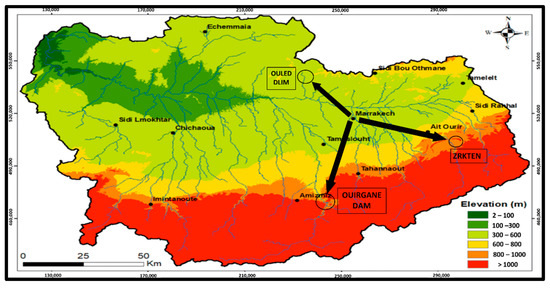
Figure 1.
Soils according to Tensift watershed map.
The used lime is a dry powder traditionally manufactured by calcining natural calcium carbonate rocks in the region of Marrakesh (Figure 2a). Lime is a hydraulic binder that needs water to become slaked according to Equation (1).
CaO + H2O → Ca(OH)2
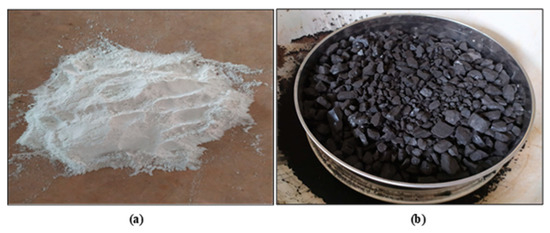
Figure 2.
(a) Lime 0/1 mm. (b) Coal aggregates 0/40 mm.
In the present study, lime was sifted at 1 mm, to avoid forming granular particles. According to Lyons [27], using hydraulic lime provides some of the Portland cement properties.
The used natural coal aggregates, imported from China (Figure 2b), were taken from the thermal power factory’s stocks of Safi. This city is located in the west of Marrakesh (157 km). The granulometry of these aggregates is between fractions of 0/40 mm. In this study, we opted for the fraction 2/20 mm.
2.2. Experimental Methods
To identify the soil properties, it has to undergo several known tests, such as particle size analysis, plasticity index, chemical, and mechanical tests [28]. Afterward, we will choose among the three soils we have, which one is the more suitable for earth construction. Then, the selected soil will be reconstructed by adding lime and coal aggregates to obtain better thermo-mechanical properties.
The particle size analysis was realized according to the Moroccan standard NM EN 933-1 [29]. The soil is sieved in a series of sieves with a diameter from 0.08 up to 2 mm. Then, the results were compared with standards used in earth construction in France [30,31] and Spain [32].
The Atterberg limits test was realized according to the Moroccan standards NM ISO/TS 17892-12 [33]. The test is conducted with a fraction of soil less than 400 μm. After sieving the soil, it was slightly dried in the oven. Then, the soil was retrieved and thoroughly mixed to pass it on a process of lowering the water content until reaching the plastic and liquid limits. The Proctor test was established according to the Moroccan standard [34]. In this test, the soil is placed in a standard mold in five compacted layers. Then, we calculate the optimal dry density in the function of the water content of the soil.
The chemical analysis was conducted by the ICP-MS (Inductively Coupled Plasma-Mass Spectrometry), which was then carried out on powdery samples by an Epsilon 4 Benchtop XRF-EDS (X-ray fluorescence -Energy Dispersive Spectrometry) Analyzer. Samples were milled and put in the sample container [35,36].
The specific weight was calculated by measuring weight and dividing by volume at 0 days and 28 days. As to the compressive test of the CEB, two approaches were considered. Firstly, as it is outlined in the standards of Colombia [37], France [30], and the RILEM TC 164 [38], CEB were cut in halves, stacked, and bonded with the aid of earth mortar, cement mortar, or both, then, bed jointed to double the slenderness ratio of the test specimen. Secondly, the Spanish standard UNE 41410 [39] measures the compressive strength by putting the whole CEB directly between platens. In our case, both techniques were used and compared.
Thermal conductivity is defined as a substance’s capacity to transmit temperature. As the substance’s thermal conductivity “λ” decreases, it turns isolated. In this study, the thermal conductivity was measured using an FP2C device [40], each brick was halved into two symmetrical pieces, then a hot wire probe was placed in between them to calculate the thermal conductivity, and the results were read with an FP2C software [41].
2.3. Brick Preparation
After sieving each soil in a sieve of 0/2 mm, they are mixed in a concrete mixer (Figure 3). The shaking test [42] was used to find the optimal amount of water. This method consists of picking a small quantity of soil, compressing it in the hand, opening the hand, and then letting it drop. In case the sample is fine-grained and did not maintain the form produced by the hand, this means that you should add more water to the mixture. If the soil retains its shape and gets ruptured into pieces at the moment of its dropping, this allows the inference that it contains a proper wetness for a good compaction. Finally, if the soil is plastic in the hand, leaves small traces of moisture on the fingers, and stays in one piece when dropped, it has too much moisture for compaction [42]. Then, the mixture is embodied into the mold of the Brava machine (Figure 3b). The Used Brava machine is an industrialized machine to prepare CEBs (Figure 3c,d).
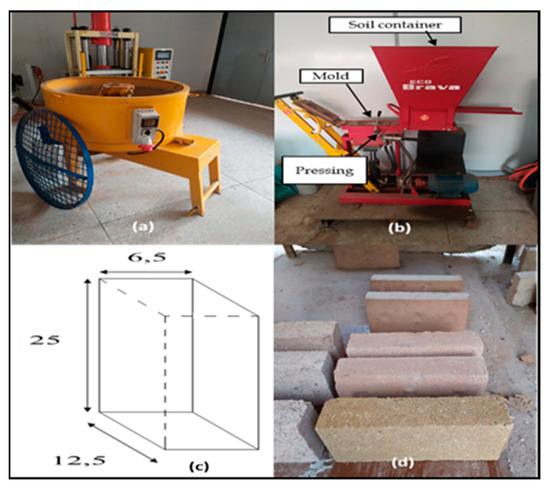
Figure 3.
(a) Mixer; (b) Brava machine; (c) Mold dimensions in cm; (d) CEB samples.
3. Discussion
3.1. Soil Identification Results
The results of the particle size analysis are shown in Figure 4. The standard limits were taken from the minimums and maximums of the previous norms [28,29,32]. The comparison outlined that the soil of Ouirgane is the only one out of standard recommendations [30,43], considering the important amount of sand in this soil as in Figure 3 and our previous work [44].
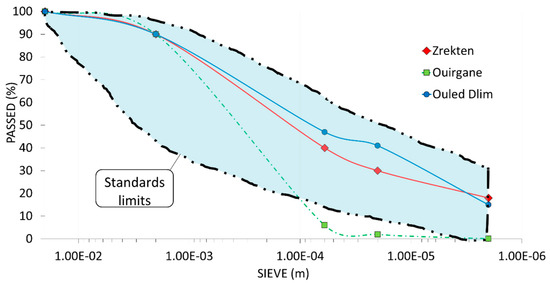
Figure 4.
The standardization of particle size analysis [30,43].
As Table 1 shows, the plasticity index (PI) approximated 17%, 15%, and 14% for “Ouled Dlim”, “Zrekten”, and “Ouirgane”, respectively. Thereby, we can say that all the studied soils are considered slightly clayey with medium plasticity. Indeed, in the work of Siwei et al. [45], the soil is considered slightly clayey, once Liquidity Limit (LL) and Plasticity Limit (PL) are within margin of the following equation: LL/3 < PI < LL/2.

Table 1.
Proctor tests and Atterberg limits for the soils.
To recognize if the soil is compressible, we have to calculate its density and water content through the Proctor test. Craterre et al. [28] showed that for compressible soil, the specific weight and water content ranged between 1.6–2.2 and 5–15%, respectively. In a similar study, Jimenez et al. [46] indicated that compressible soil has 1.75–2.3 kg/m3 for density and 5–15% of water content. Nevertheless, for the mechanical proprieties, according to Koutous et al. [47], an elevated amount of humidity in the soil implies low resistance and is equivalent to lower resistance. Accordingly, we can say from the results in Table 1, that our three soils are within range of the required values.
As for the chemical composition of the soils (Figure 5), the ICP-MS results combined with the XRF-EDS indicate that the sample of Ouled Dlim contains the upmost Magnesium Oxide (MgO) amount. Magnesium oxide refers to a low alkaline solidifying component with the least environmental burden that is employed for boosting compressive strength and CEB’s water resistance [48]. Ouirgane’s soil contains fewer amounts of Magnesium Oxide and Calcium Oxide (CaO), which shows that this soil has poor cementitious behavior. Finally, despite the weak amount of Magnesium Oxide in Zrekten soil, it contains an important amount of Calcium Oxide (17.93%) that will create cementitious bonds within the soil.
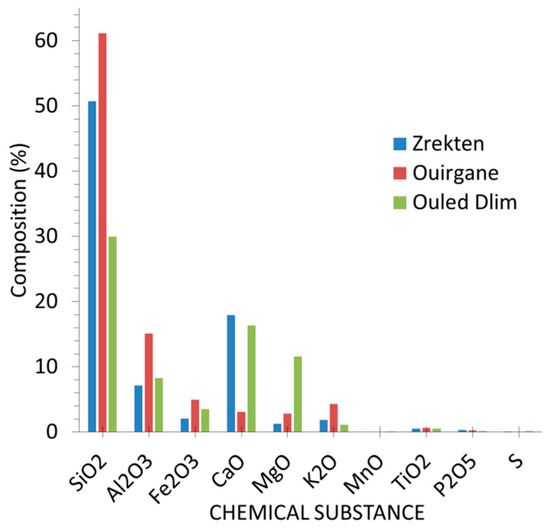
Figure 5.
Chemical analysis of the soils.
As to the geological age, our previous work [40], showed that Ouled Dlim’s soil belongs to the Lower Cretaceous, according to Kamal Taj-Eddine [49], confirming the possible cementitious behavior of the soil. Secondly, the soil of the Ouirgane dam is of heterogeneous origin, mainly from Medium Cambrian. Finally, it can be seen that the soil of Zrekten is from the Basalta of the upper Triassic [50].
Using the Brava machine, CEB were made from each soil with no additives. After 28 days of curing, their compressive strengths were investigated (Figure 6). It was found that the soil of Ouled Dlim has the highest compressive strength (0.88 MPa). These results confirmed our chemical and geological conclusions, whereas the dam’s deposit soil has the least amount of strength, with a value of about (0.62 MPa). This can be accounted for the small percentage of soil fragments and the sand’s great percentage in the dam’s deposit soil. The strength values of the three soils are low according to Colombian standards [37] France [30], and the RILEM TC 164 [38] where the down limit for the compressive strength is 1.2 MPa. As a consequence, these soils should be reinforced to use in earth construction.
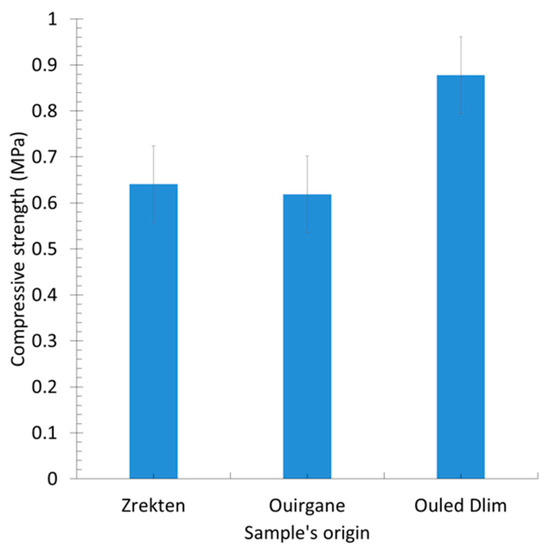
Figure 6.
Compressive strength results for the studied soils.
3.2. Formulation
Based on the identification results, we selected Ouled Dlim soil to prepare our CEB. This soil will be reinforced by lime (and CA) to enhance its mechanical and thermal properties. As we can notice in Table 2, the used CA have a low specific weight which will contribute to producing lightweight construction materials. Moreover, the used lime contains an important percentage of CaO and MgO that confirms its cementous behavior. Lime will fill the emptiness that appears in the fragments of soil and consolidate them, leading to the enhancement of the mechanical proprieties and endurance of the bricks.

Table 2.
Materials composition.
In this study, three weight percentages of CA were studied (10, 15, and 20 %wt). First, we checked the granulometry of all mixtures embedded standards recommendations for earth construction established by Craterre and Houben et al. [30,43] (Figure 7). Then, to enhance the cohesion between the soil and CA, we added 4% lime to the formulations. Many works indicated that the optimum percentage of lime is 4% of volume to avoid forming lime aggregate [49,51]. To bring insights on the influence that lime has on our bricks, the three percentages of CA were used with and without lime. These bricks will be referenced to bricks made with raw earth and others with raw earth and lime, which leads us to eight formulations, as indicated in Table 3. The percentage of water used for the mixture is based on the shaking hand test [42]. After several trials, the result found is a water ratio of 25.5% combined with raw earth, and that ratio changes after adding lime or CA or both (Figure 8).
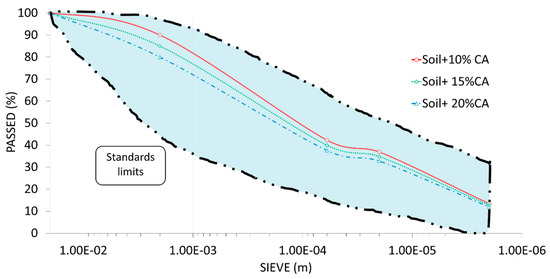
Figure 7.
Particle size analysis of the reconstructed soil with 10%, 15%, and 20% of CA according to standards [30,43].

Table 3.
Formulations composition.
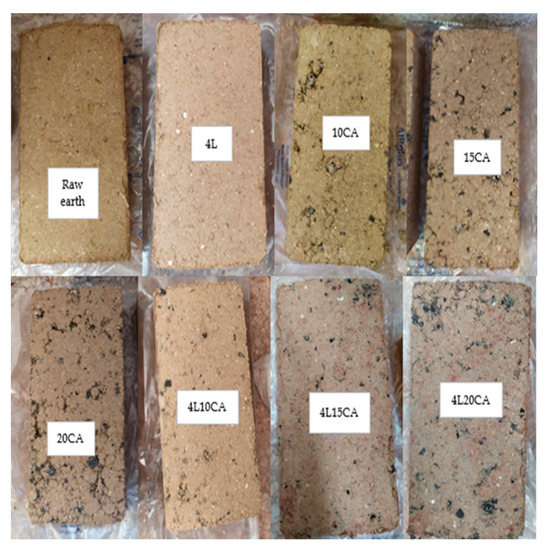
Figure 8.
The eight studied CEB Formulations.
3.3. Reconstructed Soil Results
3.3.1. Specific Weight
The specific weight (SW) of all formulations was calculated twice, just after the production and after 28 days of curing (Figure 9). It was found that with the incorporation of CA, the SW has decreased slightly by 1, 3, and 6% for CEB reinforced by 10, 15, and 20% of CA in respect to the reference brick (Figure 9a). After 28 days of curing, we noticed that the decrease in SW was more significant. For example, CEB with 20% has reached a difference of 12%.
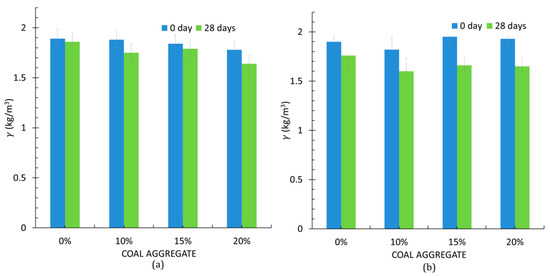
Figure 9.
(a) Specific weight without lime, (b) Specific weight with 4% lime.
Once the lime is added to the formulations, the loss in SW gradually becomes more notable, especially after 28 days of curing. In fact, after the production, the SW loss was only about 6% under 4% of lime, and reached 12 % after 28 days of curing. As an example, CEB with 20% of CA and 4% of lime has reached a 12% difference to raw earth results under the same circumstances (Figure 9b).
This result can be linked to the fact that lime increases the bond between soil particles and CA, which gives more soil pores. All brick samples show a specific weight between 1.60 t/m3 and 2.00 t/m3.
3.3.2. Compressive Strength
According to the PR XP P13-901 norm [30], bricks were cut in halves and bonded with cement mortar. Then, the obtained halved brick was compressed. Figure 10 clearly shows that the compressive strength (CS) obtained with this technique is less than half of the one using the whole brick. This can be explained by the fact that the cutting leads to cracks creation, which weakened the halved bricks. We do not recommend this technique for CEBs. Thereby, our analysis of the effect of CA and lime on the CEBs strength is based on the technique of using the whole brick.
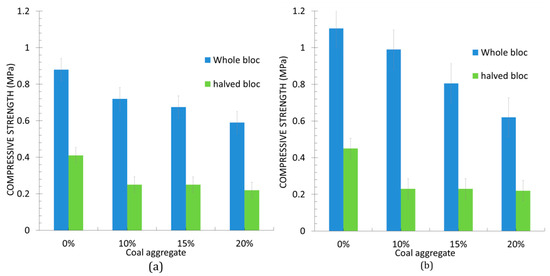
Figure 10.
Compressive strength of brick samples vs coal aggregates: (a) without lime, (b) with 4% of lime.
Moreover, we can see from Figure 10 that an incorporation of 4% of lime enhanced the compressive strength at 28 days of curing by 25.57%, in regard to raw earth bricks. This result is in line with many studies in the literature [11,13,14].
However, the compressive strength dropped linearly with the increase of CA percentages, reaching a 32.95% loss compared to raw earth for formulation with 20% of CA (Figure 10a). The addition of lime increased the compressive strength by 37.5%, 20%, and 5%, respectively, for formulation with 10%, 15%, and 20% of CA, with respect to formulations without lime (Figure 10b). The increase in CS is related to a higher amount of CA, presenting a lack in connecting CA particles with the soil, which needs more binder to bond its granular particles to those of the soil.
Our formulations present intermediate results of 0.99, 0.81, and 0.62 MPa with L10CA, L15CA, and L20CA, respectively, compared to reinforcements, such as barley straw 0.4 MPa [18] and lavender straw 0.6 MPa [18] from the literature (Table 4).
3.3.3. Thermal Conductivity
The thermal conductivity results of the studied bricks are presented in Figure 11. Adding only lime has a very slight impact on the thermal conductivity of the CEBs. However, the incorporation of coal aggregates shows a significant impact. The thermal conductivity decreased linearly with the addition of CA, especially with the presence of lime. For example, bricks with lime and 20% of CA have a thermal conductivity of less than 60% regarding the reference CEB. This is due to the low thermal proprieties of CA compared to the one of raw earth. Nevertheless, the thermal conductivity based on the CA amount in the bricks behaves differently with and without lime. The linear dependency of thermal conductivities observed in Figure 11, were obtained with resolution coefficients of R² = 0.8963 without lime and R² = 0.931 with 4% lime, and with the following equations, Equations (2) and (3):
With lime λ = −1.8617(CA%) + 0.6429
Without lime λ = −0.5686(CA%) + 0.6437
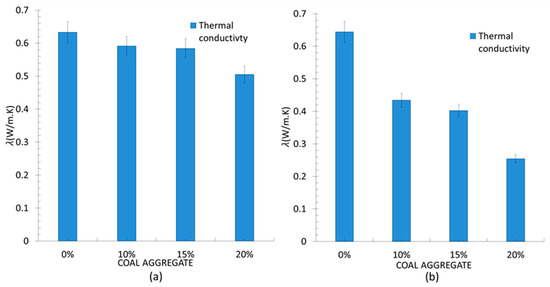
Figure 11.
Thermal conductivity results of sample bricks in the function of CA percentage: (a) without lime, (b) with 4% of lime.
At its heart, this investigation aims to identify and optimize the formulation of CEBs boosted with CA. Therefore, as in Figure 12, the optimal reinforcement percentage of CA is 15%, due to its mechanical properties and suitable thermal behavior. The addition of lime makes soil particles coarser which results in creating important macropores in the soil, leading to the enhancement of the thermal behavior of brick samples, as explained by Le Runigo [52].

Figure 12.
Thermomechanical diagram of the different CEB formulations.
Using 15% of CA with lime prevents the brick from brittle by providing a slight drop of 9% in the compressed strength but reducing its thermal conductivity by 37.17%, with respect to the reference CEB.
In evaluating how CA affects the thermal insulation performance of CEBs, Table 4 portrays the thermal conductivity results of CEBs boosted with different vegetal fibers. The difference between the raw and modified state in the case of 20% of CA was similar to results with Alfa and straw fibers. Nevertheless, the CA have a fixed composition and constant proprieties unlike the vegetal fibers that are highly affected by the growing condition and extraction area. Moreover, the biodegradability of the vegetal fibers will reduce the durability of the compressed earth bricks.


Table 4.
Thermal conductivity/compressive strength of our bricks compared to the ones insulating materials presented in the literature.
Table 4.
Thermal conductivity/compressive strength of our bricks compared to the ones insulating materials presented in the literature.
| Composition | Thermal Conductivity (W/m.K) | Raw Soil Thermal Conductivity (W/m.K) | Difference between Raw and Modified State | Compressive Strength (MPa) | Reference |
|---|---|---|---|---|---|
| L20CA | 0.256 | 0.635 | 60% | 0.62 | Our Study |
| L15CA | 0.399 | 0.635 | 37.17% | 0.81 | Our Study |
| L10CA | 0.433 | 0.635 | 32% | 0.99 | Our Study |
| Clay + 4%Alfa | 0.372 | 0.938 | 60.34% | 1.75 | [53] |
| Clay + 4%straw | 0.34 | 0.938 | 63.75% | 1.53 | [53] |
| Clay + 6% argan nuts + 5% cement | 0.481 | 0.865 | 44.39% | 1.85 | [54] |
| Raw earth + 6% barley straw | 0.155 | 0.471 | 67.09% | 0.4 | [18] |
| Raw earth + 6% lavender straw | 0.289 | 0.471 | 38.64% | 0.6 | [18] |
| 74%Laterite + 20%sand +6%cement | 0.69 | 0.8 | 13.75% | 2.5 | [55] |
| Raw earth + 30% olive waste | 0.4 | 0.65 | 38.46% | _ | [20] |
| Raw earth + 30% dates palm fiber | 0.28 | 0.65 | 56.92% | _ | [20] |
| Raw earth + 30% straw | 0.26 | 0.65 | 60.00% | _ | [20] |
3.3.4. Economical Manufacturing CEBs Comparison
In Morocco, the price for manufacturing earth bricks with only raw earth is around 0.21 USD/brick, while the price for earth bricks with 5% of cement as a binder is around 0.37 USD/brick, according to local companies of earth construction. In Table 5, we can see that the price of earth bricks reinforced with coal aggregates is less than the price of earth bricks with 5% of cement.

Table 5.
CEB Cost of manufacturing.
4. Conclusions
In general, we can conclude that the soil from Ouled Dlim area is the most suitable for the compressed earth bricks CEBs production in Marrakech region because of its good granulometry, specific weight, and plasticity index. Besides, this soil has the highest amount of magnesium oxide (MgO) and calcium oxide (CaO) that predict a good cementitious behavior, which was experimentally confirmed with 0.88 MPa in compressive strength. The addition of coal aggregates to the selected soil has resulted in a significant decrease of the specific weight of the CEBs. In fact, CEBs manufactured with 15 wt% (optimal value) of coal aggregates are 11% lighter than the referenced bricks. However, the compressive strength of CEBs was found to decrease with the addition of coal aggregates. Thereby, even with the addition of lime, to meet the international standards on compressive strength of CEBs, we recommend to not exceed 15% of CA. On the contrary, the thermal conductivity was improved by 60 and 37%, with incorporation of 20 and 15% of CA, respectively.
Considering the above, we can say that CA are a good alternative to vegetal fibers in CEBs since they are available in large quantities with constant proprieties, reasonably priced and, not biodegradable. Moreover, the use of CA in CEBs will minimize the environmental impact of the fossil industry and improve the energy performance of the building sector.
Author Contributions
M.L. contributed to the overall study, analysis and writing of the manuscript. F.-E.E.A. and S.S. provided support on mechanical analysis and supervision. A.A. provided support on chemical analysis and text modification. All authors have read and agreed to the published version of the manuscript.
Funding
This research has no financial support beside the institutional elementary (Cadi Ayyad University).
Institutional Review Board Statement
Not applicable.
Informed Consent Statement
Not applicable.
Data Availability Statement
Not applicable.
Conflicts of Interest
The authors declare no conflict of interest.
References
- Al-Fakih, A.; Mohammed, B.S.; Liew, M.S.; Nikbakht, E. Incorporation of waste materials in the manufacture of masonry bricks: An update review. J. Build. Eng. 2019, 21, 37–54. [Google Scholar] [CrossRef]
- Zami, M.S.; Lee, A. Economic benefits of contemporary earth construction in low-cost urban housing—State-of-the-art review. J. Build. Apprais 2010, 5, 259–271. [Google Scholar] [CrossRef]
- Pacheco-Torgal, F.; Jalali, S. Earth construction: Lessons from the past for future eco-efficient construction. Constr. Build. Mater. 2012, 29, 512–519. [Google Scholar] [CrossRef]
- Widder, L. Earth eco-building: Textile-reinforced earth block construction. Energy Procedia 2017, 122, 757–762. [Google Scholar] [CrossRef]
- Murmu, A.L.; Patel, A. Towards sustainable bricks production: An overview. Constr. Build. Mater. 2018, 165, 112–125. [Google Scholar] [CrossRef]
- Danso, H.; Martinson, D.B.; Ali, M.; Williams, J.B. Physical, mechanical and durability properties of soil building blocks reinforced with natural fibres. Constr. Build. Mater. 2015, 101, 797–809. [Google Scholar] [CrossRef]
- Bi, W.; Yan, Z.; Zhao, H.; Sun, L.; Wang, X.; Zhang, Z. The Influence of Two Natural Reinforcement Fibers on the Hygrothermal Properties of Earthen Plasters in Mogao Grottoes of China. J. Renew. Mater. 2020, 8, 1691–1710. [Google Scholar] [CrossRef]
- Javed, U.; Khushnood, R.A.; Memon, S.A.; Jalal, F.E.; Zafar, M.S. Sustainable incorporation of lime-bentonite clay composite for production of ecofriendly bricks. J. Clean. Prod. 2020, 263, 121469. [Google Scholar] [CrossRef]
- Delgado, M.C.J.; Guerrero, I.C. Earth building in Spain. Constr. Build. Mater. 2006, 20, 679–690. [Google Scholar] [CrossRef]
- Raheem, A.A.; Bello, O.A.; Makinde, O.A. A Comparative Study of Cement and Lime Stabilized Lateritic Interlocking Blocks. Pacific J. Sci. Technol. 2010, 11, 27–34. [Google Scholar]
- Miqueleiz, L.; Ramírez, F.; Seco, A.; Nidzam, R.M.; Kinuthia, J.M.; Tair, A.A.; Garcia, R.A. The use of stabilised Spanish clay soil for sustainable construction materials. Eng. Geol. 2012, 133–134, 9–15. [Google Scholar] [CrossRef]
- Nagaraj, H.B.; Sravan, M.V.; Arun, T.G.; Jagadish, K.S. Role of lime with cement in long-term strength of Compressed Stabilized Earth Blocks. Int. J. Sustain. Built Environ. 2014, 3, 54–61. [Google Scholar] [CrossRef]
- Imanzadeh, S.; Hibouche, A.; Jarno, A.; Taibi, S. Formulating and optimizing the compressive strength of a raw earth concrete by mixture design. Constr. Build. Mater. 2018, 163, 149–159. [Google Scholar] [CrossRef]
- Basma, A.A.; Tuncer, E.R. Effect of lime on volume change and compressibility of expansive clays. Trans Res. Rec. C 1991, 1295, 52–61. [Google Scholar]
- Chen, X.-F.; Jiao, C.-J. Microstructure and physical properties of concrete containing recycled aggregates pre-treated by a nano-silica soaking method. Build. Eng. 2022, 51, 104363. [Google Scholar] [CrossRef]
- Taha, Y.; Benzaazoua, M.; Hakkou, R.; Mansori, M. Coal mine wastes recycling for coal recovery and eco-friendly bricks production. Miner. Eng. 2017, 107, 123–138. [Google Scholar] [CrossRef]
- Vavřínová, N.; Stejskalová, K.; Teslík, J.; Kubenková, K.; Majer, J. Research of Mechanical and Thermal Properties of Composite Material Based on Gypsum and Straw. J. Renew. Mater. 2022, 10, 1859–1873. [Google Scholar] [CrossRef]
- Giroudon, M.; Laborel-Préneron, A.; Aubert, J.E.; Magniont, C. Comparison of barley and lavender straws as bioaggregates in earth bricks. Constr. Build. Mater. 2019, 202, 254–265. [Google Scholar] [CrossRef]
- Ajouguim, S.; Talibi, S.; Djelal-Dantec, C.; Hajjou, H.; Waqif, M.; Stefanidou, M.; Saadi, L. Effect of Alfa fibers on the mechanical and thermal properties of compacted earth bricks. Mater. Today Proc. 2019, 37, 4049–4057. [Google Scholar] [CrossRef]
- Lamrani, M.; Mansour, M.; Laaroussi, N.; Khalfaoui, M. Thermal study of clay bricks reinforced by three ecological materials in south of Morocco. Energy Procedia 2019, 156, 273–277. [Google Scholar] [CrossRef]
- Khoudja, D.; Taallah, B.; Izemmouren, O.; Aggoun, S.; Herihiri, O.; Guettala, A. Mechanical and thermophysical properties of raw earth bricks incorporating date palm waste. Constr. Build. Mater. 2021, 270, 121824. [Google Scholar] [CrossRef]
- Mushtaq, Z.; Wei, W.; Jamil, I.; Sharif, M.; Chandio, A.A.; Ahmad, F. Evaluating the factors of coal consumption inefficiency in energy intensive industries of China: An epsilon-based measure model. Resour. Policy 2022, 78, 102800. [Google Scholar] [CrossRef]
- Masuka, S.; Gwenzi, W.; Rukuni, T. Development, engineering properties and potential applications of unfired earth bricks reinforced by coal fly ash, lime and wood aggregates. J. Build. Eng. 2018, 18, 312–320. [Google Scholar] [CrossRef]
- Meliho, M.; Khattabi, A.; Mhammdi, N. Spatial assessment of soil erosion risk by integrating remote sensing and GIS techniques: A case of Tensift watershed in Morocco. Environ. Earth Sci. 2020, 79, 1–19. [Google Scholar] [CrossRef]
- Zhang, K.; Wei, Q.; Jiang, S.; Shen, Z.; Zhang, Y.; Tang, R.; Yang, A.; Chow, C.W. Utilization of Dredged River Sediment in Preparing Autoclaved Aerated Concrete Blocks. J. Renew. Mater. 2022, 10, 1–20. [Google Scholar] [CrossRef]
- Serbah, B.; Abou-Bekr, N.; Bouchemella, S.; Eid, J.; Taibi, S. Dredged sediments valorisation in compressed earth blocks: Suction and water content effect on their mechanical properties. Constr. Build. Mater. 2018, 158, 503–515. [Google Scholar] [CrossRef]
- Lyons, A. Lime, cement and concrete. In Materials for Architects and Builders; Routledge: Oxfordshire, UK, 2020; pp. 79–138. [Google Scholar] [CrossRef]
- Moevus, M.; Fontaine, L.; Anger, R.; Doat, P. Mariette Projet: Béton d’Argile Environnemental (B.A.E.); CRAterre, ENSAG, Ministère de l’Écologie, du Développement Durable et de l’Énergie: Paris, France, 2013; 877p.
- IMANOR NM EN 933-1; Essais pour Déterminer les Caractéristiques Géométriques des Granulats—Partie 1: Détermination de la Granularité—Analyse Granulométrique par Tamisage. IMANOR: Rabat, Marroco, 2018.
- PR XP P13-901; Blocs de Terre Comprimée pour Murs et Cloisons Définitions-Spécifications—Méthodes D’essai—Conditions de Réception. AFNOR: Saint Denis, France, 2017.
- Van Damme, H.; Houben, H. Earth concrete. Stabilization revisited. Cem. Concr. Res. 2018, 114, 90–102. [Google Scholar] [CrossRef]
- MOPT. Bases Para el Diseno y Construcción con Tapial; Centro de Publicaciones, Secretaria General Técnica Ministerio de Obras Públicas y Transportes: Madrid, Spain, 1992.
- IMANOR NM ISO/TS 17892-12; Reconnaissance et essais géotechniques—Essais de sol au laboratoire—Partie 12: Détermination des limites d’Atterberg. IMANOR: Rabat, Marroco, 2015.
- NM 13.1.023; Sols: Reconnaissance et essais Determination des References de Compactage d un Materiau Essai Proctor Normal Essai Proctor Modifie. IMANOR: Rabat, Morocco, 2019.
- Mouiya, M.; Arib, A.; Taha, Y.; Tamraoui, Y.; Hakkou, R.; Alami, J.; Huger, M.; Tessier-Doyen, N. Characterization of a chiastolite-type andalusite: Structure and physicochemical properties related to mullite transformation. Mater. Res. Express 2022, 9, 74002. [Google Scholar] [CrossRef]
- Amrani, M.; Taha, Y.; Kchikach, A.; Benzaazoua, M.; Hakkou, R. Phosphogypsum recycling: New horizons for a more sustainable road material application. J. Build. Eng. 2020, 30, 101267. [Google Scholar] [CrossRef]
- NTC 5324; Bloques de Suelo Cemento para Muros y Divisiones: Definiciones, Especificaciones, Métodos de Ensayos Condiciones de Entrega. ICONTEC: Bogotá, Colombia, 2004.
- Olivier, M.; Mesbah, A.; Morel, J.C.; El Gharbi, Z. Test Methods for strength tests on blocks of compressed earth. Mode opératoire pour la réalisation d’essais de résistance sur blocs de terre comprimée. Mater. Struct. 1997, 30, 515–517. [Google Scholar] [CrossRef]
- UNE 41410; Compressed Earth Blocs for Walls and Partitions: Definitions, Specifications and Test Methods. UNE: Madrid, Spain, 2008.
- Quang, T.N.; Hervi, D.B.; Cédrc, S. Determination of thermal properties of asphalt mixtures as another output from cy-clic tension-compression test. Road Mater. Pavement Des. 2012, 13, 85–103. [Google Scholar]
- Boukhattem, L.; Boumhaout, M.; Hamdi, H.; Benhamou, B.; Nouh, F.A. Moisture content influence on the thermal conductivity of insulating building materials made from date palm fibers mesh. Constr. Build. Mater. 2017, 148, 811–823. [Google Scholar] [CrossRef]
- Guering, L. Construction à Faible Coût dans les Programmes Spéciaux de Travaux Publics; Principes Directeurs pour L’emploi de la Terre Crue; Bureau International du Travail: Genève, Switzerland, 1985. [Google Scholar]
- Hugo, G.H.H. Earth Construction: A Comprehensive Guide; Intermediate Technology Publications: Stanford, CA, USA, 1994. [Google Scholar]
- Lahdili, M.; El Abbassi, F.E.; Sakami, S.; Aamouche, A. The improvement of mechanical and thermal behavior of local compressed Earth blocks. AIP Conf. Proc. 2021, 2345, 020040. [Google Scholar] [CrossRef]
- Ma, S.K.S.; Qian, Y. Performance-based study on the rheological and hardened properties of blended cement mortars incorporating palygorskite clays and carbon nanotubes. Constr. Build. Mater. 2018, 171, 663–671. [Google Scholar] [CrossRef]
- Delgado, M.C.J.; Guerrero, I.C. The selection of soils for unstabilised earth building: A normative review. Constr. Build. Mater. 2007, 21, 237–251. [Google Scholar] [CrossRef]
- Koutous, A.; Hilali, E. Grain shape effects on the mechanical behavior of compacted earth. Case Stud. Constr. Mater. 2019, 11, e00303. [Google Scholar] [CrossRef]
- Yu, B.; Zhou, J.; Cheng, B.; Yang, W. Compressive strength development and microstructure of magnesium phosphate cement concrete. Constr. Build. Mater. 2021, 283, 122585. [Google Scholar] [CrossRef]
- Taj-Eddine, J.-P.T.K.; Rey, J.; Canérot, J.; Peybernés, B. Lithostratigraphy, biostratigraphy and sedimentary dynamics of the Lower Cretaceous deposits on the northern side of the western High Atlas (Morocco). Cretac. Res. 1988, 141–158. [Google Scholar]
- Missenard, M.S.Y.; Taki, Z.; de Lamotte, D.F.; Benammi, M.; Hafid, M.; Leturmy, P. Tectonic styles in the Marrakesh High Atlas (Morocco): The role of heritage and mechanical stratigraphy. J. Afr. Earth Sci. 2007, 48, 247–266. [Google Scholar] [CrossRef]
- Gundu, R. Carbonate/clay-mineral relationships and the origin of protodolomite in l-2 and l-3 carbonate reservoir rocks of the bombay high oil field, INDIA. Sediment. Geol. 1981, 29, 223–232. [Google Scholar] [CrossRef]
- Le Runigo, D.D.B.; Cuisinier, O.; Cui, Y.-J.; Ferber, V. Impact of initial state on the fabric and permeability of a lime-treated silt under long-term leaching. Can. Geotech. J. 2009, 46, 1243–1257. [Google Scholar] [CrossRef]
- El Hamdouni, Y.; Khabbazi, A.; Benayad, C.; Dadi, A.; Ahmid, O.I. Contribution to the Thermal and Mechanical Behavior of the Two Materials at the Base of Clay Reinforced by Fibers ALFA and of Straw Fibers. Res. J. Appl. Sci. Eng. Technol. 2016, 12, 490–497. [Google Scholar] [CrossRef]
- Tatane, M.; Elminor, H.; Ayeb, M.; Lacherai, A.; Feddaoui, M.; Aitnouh, F.; Boukhattem, L. Effect of Argan Nut Shell Powder on Thermal and Mechanical Behavior of Compressed Earth Blocks Performance des panneaux photovoltaïques View project PROPRE.MA View project Effect of Argan Nut Shell Powder on Thermal and Mechanical Behavior of Compressed E. Int. J. Appl. Eng. Res. 2018, 13, 4740–4750. Available online: http://www.ripublication.com (accessed on 1 September 2022).
- Toure, P.M.; Sambou, V.; Faye, M.; Thiam, A. Mechanical and thermal characterization of stabilized earth bricks. Energy Procedia 2017, 139, 676–681. [Google Scholar] [CrossRef]
Publisher’s Note: MDPI stays neutral with regard to jurisdictional claims in published maps and institutional affiliations. |
© 2022 by the authors. Licensee MDPI, Basel, Switzerland. This article is an open access article distributed under the terms and conditions of the Creative Commons Attribution (CC BY) license (https://creativecommons.org/licenses/by/4.0/).